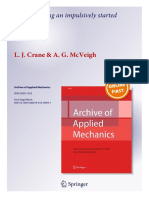Lec3 Intro Turb
Lec3 Intro Turb
Uploaded by
Abhishek ChintaguntaCopyright:
Available Formats
Lec3 Intro Turb
Lec3 Intro Turb
Uploaded by
Abhishek ChintaguntaCopyright
Available Formats
Share this document
Did you find this document useful?
Is this content inappropriate?
Copyright:
Available Formats
Lec3 Intro Turb
Lec3 Intro Turb
Uploaded by
Abhishek ChintaguntaCopyright:
Available Formats
Outline
Examples
Description
Reynolds number
Kolmogorov cascade
Summary
Notes
DEN403/DENM010 Computational Fluid Dynamics
Part 3: Introduction to turbulence Dr. Jens-Dominik Muller School of Engineering and Materials Science, Queen Mary, University of London
j.mueller@qmul.ac.uk Room: Eng 122 ofce hours: any reasonable time c Jens-Dominik Muller, 2011
1 / 37
Outline
Examples
Description
Reynolds number
Kolmogorov cascade
Summary
Organisation of the lectures on turbulence
1. Introduction
Motivating examples, description of turbulence The Reynolds number The Kolmogorov cascade
Notes
2. Reynolds-Averaged Navier-Stokes
Averaging the Navier-Stokes equations Reynolds stresses, closure Modelling the Reynolds stresses
3. Using RANS
The near-wall structure of turbulent boundary layers Mesh spacing requirements, wall functions Limits of applicability
4. Alternative approaches
DNS, LES, DES
2 / 37
Outline
Examples
Description
Reynolds number
Kolmogorov cascade
Summary
Outline of this part
Notes
Examples of turbulent ow Description of turbulence The Reynolds number The Kolmogorov Cascade Summary
3 / 37
Outline
Examples
Description
Reynolds number
Kolmogorov cascade
Summary
Outline of this part
Notes
Examples of turbulent ow Description of turbulence The Reynolds number The Kolmogorov Cascade Summary
4 / 37
Outline
Examples
Description
Reynolds number
Kolmogorov cascade
Summary
On Turbulence
Benoit Mandelbrot: The techniques I developed for studying turbulence, like weather, also apply to the stock market. Werner Heisenberg: When I meet God, I am going to ask him two questions: Why relativity? And why turbulence? I really believe he will have an answer for the rst.
(Source: Great-Quotes.com, Wikipedia)
Notes
5 / 37
Outline
Examples
Description
Reynolds number
Kolmogorov cascade
Summary
An artists view of turbulence
Notes
Leonardo da Vinci
6 / 37
Outline
Examples
Description
Reynolds number
Kolmogorov cascade
Summary
Turbulence on a global scale
Notes
Flow around Selkirk island
(Source: NOAA) 7 / 37
Outline
Examples
Description
Reynolds number
Kolmogorov cascade
Summary
Reynolds experiment
Notes
(Source: Reynolds, 1883)
Turbulence in smooth pipes typically occurs above Re = 2000.
8 / 37
Outline
Examples
Description
Reynolds number
Kolmogorov cascade
Summary
Effect of Reynolds number
Notes
Re = 15, 000
(Source: van Dyke: Album of uid motion)
Re = 30, 000
9 / 37
Outline
Examples
Description
Reynolds number
Kolmogorov cascade
Summary
Laminar and turbulent ow II
Notes
10 / 37
Outline
Examples
Description
Reynolds number
Kolmogorov cascade
Summary
Turbulent combustion I
Notes
Turbulent mixing downstream of a swirler
(Source: CERFACS) 11 / 37
Outline
Examples
Description
Reynolds number
Kolmogorov cascade
Summary
Turbulent combustion II
Notes
Turbulent combustor
(Source: CERFACS) 12 / 37
Outline
Examples
Description
Reynolds number
Kolmogorov cascade
Summary
Turbulent combustion III
Notes
Ignition simulation in an annular combustor
(Source: CERFACS) 13 / 37
Outline
Examples
Description
Reynolds number
Kolmogorov cascade
Summary
Outline of this part
Notes
Examples of turbulent ow Description of turbulence The Reynolds number The Kolmogorov Cascade Summary
14 / 37
Outline
Examples
Description
Reynolds number
Kolmogorov cascade
Summary
Characteristics of turbulence
Turbulence is inherently unsteady and 3-dimensional. Turbulence is dominated by chaotic - but not random
Notes
motion of swirling structures, the eddies.
There is a cascade of eddies, largest eddies determined
e.g. by the geometry.
Largest scales take their energy from mean ow. Larger eddies break up, passing their energy to smaller
scales.
Smallest scales dissipate their energy into heat. Is always dissipative, i.e. increases mixing, disorder. The Reynolds number will play a major role. Nearly all relevant industrial ows are turbulent!
15 / 37
Outline
Examples
Description
Reynolds number
Kolmogorov cascade
Summary
How does turbulence arise?
A at plate boundary layer
starts out laminar transitions from laminar
Notes
to turbulence after some running length
remains turbulent
downstream of transition
transition modelling is
very complex: in CFD typically full turbulence is assumed.
16 / 37
Outline
Examples
Description
Reynolds number
Kolmogorov cascade
Summary
Laminar vs. turbulent boundary layers
The laminar b.l. prole
Notes
has a lower velocity gradient u near the y wall, hence a lower wall shear stress
The turb. b.l. prole has
a higher velocity near the wall, hence is more resistant to separation
The turb. b.l. has more
mixing, hence heat transfer or surface reactions are enhanced.
17 / 37
Outline
Examples
Description
Reynolds number
Kolmogorov cascade
Summary
Outline of this part
Notes
Examples of turbulent ow Description of turbulence The Reynolds number The Kolmogorov Cascade Summary
18 / 37
Outline
Examples
Description
Reynolds number
Kolmogorov cascade
Summary
The Reynolds number in the momentum equations
The momentum equ. incompr. Navier-Stokes equations in vector notation: u + u u = p + 2 u, t where u is the vector of velocities. The unit of the equation, as stated above, is force per volume: F /V = m a/V = a . Dividing the equation by this factor of this dimension, u 2 /D, which is equivalent to normalising the variables by u 1 D u = , p = p 2, , =D = U U t U t makes the equ. nondimensional: u +u t u = p + 1 Re
2
Notes
u,
Note: for Re 0 the effect of the viscous term vanishes, but the no-slip condition at the wall may remain!
19 / 37
Outline
Examples
Description
Reynolds number
Kolmogorov cascade
Summary
Reynolds number and Turbulence
Re = = momentum of the ow inertial forces = viscous forces viscous stress u2 u2 ul ul = u = = l u y
Notes
When Re 1 the ow is very viscous (creeping ow). As Re the ow becomes less dominated by viscosity,
and boundary-layers conned to small region near surfaces.
The Reynolds number depends on the choice of
length-scale!
Choosing an overall length-scale, e.g. aerofoil chord
length, provides only analysis of overall effects.
20 / 37
Outline
Examples
Description
Reynolds number
Kolmogorov cascade
Summary
Reynolds number based on length
Most simply: base Reynolds number on the length of the
Notes
body L,
but a boundary-layer grows with distance ( x 0.5 for a
laminar boundary-layer) L and are inter-related.
Instead, base Re on distance from the L.E.:
ReL = UL/
21 / 37
Outline
Examples
Description
Reynolds number
Kolmogorov cascade
Summary
Reynolds number for a boundary layer
Reynolds number:
Notes
Re =
momentum of the ow viscous sresses
momentum of the ow: U 2 viscous sresses:
= (du/dy) (U/)
Reynolds number based on
b.l. thickness: Re = U2 U U = = (U/)
22 / 37
Outline
Examples
Description
Reynolds number
Kolmogorov cascade
Summary
Outline of this part
Notes
Examples of turbulent ow Description of turbulence The Reynolds number The Kolmogorov Cascade Summary
23 / 37
Outline
Examples
Description
Reynolds number
Kolmogorov cascade
Summary
Effect of Reynolds number on small scales
Notes
med. Re
higher Re
(Source: van Dyke: Album of uid motion) 24 / 37
Outline
Examples
Description
Reynolds number
Kolmogorov cascade
Summary
Reynolds number based on eddy diameter d
Re = = momentum of the ow inertial forces = viscous forces viscous stress u2 ud ud u2 = = u = d u y
Notes
For Re >> 1, inertial forces dominate. The ow keeps
swirling, energy is passed down to smaller scales.
When Re 1, viscous forces become equal in magnitude
to inertial forces, eddies dissipate.
There is a smallest length scale for turbulent eddies!
Smaller eddies are dissipated by viscosity.
Rotational energy d 2 , hence smaller eddies contain less
energy.
25 / 37
Outline
Examples
Description
Reynolds number
Kolmogorov cascade
Summary
The Kolmogorov Cascade I
Notes
26 / 37
Outline
Examples
Description
Reynolds number
Kolmogorov cascade
Summary
The Kolmogorov Cascade II
Eddy structure is fractal with higher Re, we nd
Notes
smaller scales
smaller scales have
smaller diameters, hence in a ow with the same speed lead to uctuations with higher frequencies
in turbulent ow literature,
rather than higher frequency, the term higher wavenumber k is used.
27 / 37
Outline
Examples
Description
Reynolds number
Kolmogorov cascade
Summary
Spectrum of turbulent kinetic energy
Notes
28 / 37
Outline
Examples
Description
Reynolds number
Kolmogorov cascade
Summary
Spectrum of turbulent kinetic energy
There is a peak of overall
Notes
turbulent kinetic energy E at some wavenumber k = O(L1 ), i.e. some diameter L given by the geometry.
In isotropic turbulence
energy drops at a rate of 5 k 3 with increasing wavenumber k.
There is a smallest
wavenumber/scale which increases with Re.
29 / 37
Outline
Examples
Description
Reynolds number
Kolmogorov cascade
Summary
How small is the smallest eddy? I
Notes
The largest eddies depend on the geometry scale, e.g. b.l.
thickness or pipe diameter.
The scale of the smallest eddies, the scale at which
dissipation occurs, is independent of the scale of the largest eddies or the mean ow. At the smallest scales there is an equilibrium between
energy supplied by larger scales energy dissipated by viscosity
This is known as Kolmogorovs Universal Equilibrium
Theory
30 / 37
Outline
Examples
Description
Reynolds number
Kolmogorov cascade
Summary
How small is the smallest eddy? II
Dene the dissipation rate per unit mass [m2 sec3 ], and use the kinematic viscosity [m2 sec1 ], using dimensional analysis we can then we can derive the
Notes
Kolmogorov microscales:
Kolmogorov length scale: Kolmogorov time scale:
= =
1/4
1/2
Using dimensional analysis we can approximate U 3 /L hence the ratio of typical length L to smallest eddy size is
L 3 1/4
3 3
= L/
= (UL/) 4 = Re 4
31 / 37
Outline
Examples
Description
Reynolds number
Kolmogorov cascade
Summary
Implications of eddy scaling for CFD
L size of smallest scales: = Re
3 4
Notes
To resolve an eddy we need at least two mesh points to
represent the velocity uctuations: x = h .
hence the number of meshpoints in one direction is
L h
= Re 4
for a three-dimensional calculation we need this many
mesh points in each direction, hence the overall number of 9 nodes N scales with Re as N = (L/h)3 = Re 4
Resolving all turbulent structures is only possible for low
Re, but is prohibitive for high Re.
DNS of a complete aircraft will require at least an exaop
(1018 ops) computer. The best performance currently is a around 500 tera ops (500 1012 ops)
32 / 37
Outline
Examples
Description
Reynolds number
Kolmogorov cascade
Summary
Approaches to deal with turbulence in CFD I
Simulation of the nest scales means: resolving these
Notes
scales with mesh points such that we can accurately model them in the conservation equations.
This approach is called Direct Navier-Stokes (DNS), but is
not affordable even in the mid-term future.
We are typically not interested in the ne scale
uctuations, in engineering we care for the long-term time-averages as they would affect the ight of an aircraft.
Hence, we could approximate the average effect of these
uctuations with an additional model that embodies our knowledge of turbulent ows.
This approach is called Reynolds-averaged Navier-Stokes
(RANS), and is the most popular approach to CFD for turbulent ows.
33 / 37
Outline
Examples
Description
Reynolds number
Kolmogorov cascade
Summary
Approaches to deal with turbulence in CFD II
Notes
34 / 37
Outline
Examples
Description
Reynolds number
Kolmogorov cascade
Summary
Outline of this part
Notes
Examples of turbulent ow Description of turbulence The Reynolds number The Kolmogorov Cascade Summary
35 / 37
Outline
Examples
Description
Reynolds number
Kolmogorov cascade
Summary
Introduction to turbulence: summary I
Turbulence is unsteady and three-dimensional. The chaotic motion of turbulent ow is fully described by
Notes
the conservation equations.
There is a cascade of eddies, largest scales determined by
geometry.
Turbulence increases skin friction, but also increases
mixing.
Nearly all ows of industrial interest are turbulent. They Reynolds number can describe turbulent effects, but
care needs to be taken to choose the correct length scale.
36 / 37
Outline
Examples
Description
Reynolds number
Kolmogorov cascade
Summary
Introduction to turbulence: summary II
There is a smallest eddy scale, the Kolmogorov scale. For
Notes
smaller scales viscosity becomes dominant and eddies are dissipated.
The ratio of smallest to largest scales is Re 4 . If we were to resolve the smallest scale in a numerical ow
3
simulation, a DNS, the required number of mesh points 9 would scale with Re 4 , an unsteady computation would require an exaop computer.
For lower computational cost, we need to model the
time-averaged effect of turbulent uctuations, the Reynolds-averaged Navier Stokes approach (RANS).
There is also an intermediate approach, the Large Eddy
Simulation (LES), where the largest scales are resolved (simulated) and the sub-grid scales are modelled.
37 / 37
Notes
Notes
You might also like
- 235 Wood - 2015 PDFDocument92 pages235 Wood - 2015 PDFEdo Dakedezu100% (2)
- HW 1Document2 pagesHW 1Sambhav Jain0% (2)
- Pipe Flow Calculations PDFDocument12 pagesPipe Flow Calculations PDFharrypop418No ratings yet
- G6 Reading BKLT 2019 PDFDocument5 pagesG6 Reading BKLT 2019 PDFMG JacobNo ratings yet
- EIM GRADE 9 10 Q4 Module 1b - National Electrical Code NEC Provisions in Installing Wiring Devices - GFCI. - FinalDocument23 pagesEIM GRADE 9 10 Q4 Module 1b - National Electrical Code NEC Provisions in Installing Wiring Devices - GFCI. - FinalTitser Ramca100% (3)
- ReynoldsDocument20 pagesReynoldsNick CordetaNo ratings yet
- Unit 8 (Reynolds Number, Laminar Flow, Turbulentflow, and Energy Losses Due To Friction)Document13 pagesUnit 8 (Reynolds Number, Laminar Flow, Turbulentflow, and Energy Losses Due To Friction)MOJALEFA JACOB MOLEFINo ratings yet
- TurbDocument17 pagesTurbАкхилеш КхапреNo ratings yet
- Cornish MethodDocument30 pagesCornish MethodEverlasting MemoriesNo ratings yet
- Roughness Body Reynolds-Number: The Effect of Surface of The High FlowDocument11 pagesRoughness Body Reynolds-Number: The Effect of Surface of The High FlowLuizNo ratings yet
- Reynolds NumberDocument21 pagesReynolds NumberShiela SorinoNo ratings yet
- Thin Film ReactorsDocument9 pagesThin Film ReactorsThanh HuongNo ratings yet
- Experiments in Turbulent Pipe Flow With Polymer AdditivesDocument24 pagesExperiments in Turbulent Pipe Flow With Polymer AdditivesMichael MedinaNo ratings yet
- Transition To Turbulence: Kerosene/Water Manometer Dye Reservoir KDocument6 pagesTransition To Turbulence: Kerosene/Water Manometer Dye Reservoir Kdist2235No ratings yet
- 1987.effects of Reynolds Number and A Low Intensity Freestream Turbulence On The Flow Around A Circular Cylinder - NorbergDocument55 pages1987.effects of Reynolds Number and A Low Intensity Freestream Turbulence On The Flow Around A Circular Cylinder - NorbergRaul KörralesNo ratings yet
- Energy Loss Due To Friction PDFDocument19 pagesEnergy Loss Due To Friction PDFLim BrandonNo ratings yet
- CFD at Chapter-2Document34 pagesCFD at Chapter-2Pawan KumarNo ratings yet
- Full Experiment 3Document33 pagesFull Experiment 3Nnitesh PalaNo ratings yet
- 42 - Teng1999 PDFDocument13 pages42 - Teng1999 PDFAndré PucciarelliNo ratings yet
- Topic T2: Flow in Pipes and Channels AUTUMN 2013Document30 pagesTopic T2: Flow in Pipes and Channels AUTUMN 2013Bernard PalmerNo ratings yet
- Week 6 - Head LossDocument26 pagesWeek 6 - Head Losschantal mohammedNo ratings yet
- Hwork PDFDocument2 pagesHwork PDFSuresh Balaji VedarethinamNo ratings yet
- Heat5 (Convection II)Document48 pagesHeat5 (Convection II)ابو الجعل0% (1)
- E3. Friction Losses in Pipes and FittingsDocument15 pagesE3. Friction Losses in Pipes and FittingsMuzammil IqbalNo ratings yet
- D. Kivotides Et Al - Quantum Signature of Superfluid TurbulenceDocument4 pagesD. Kivotides Et Al - Quantum Signature of Superfluid TurbulenceJuaxmawNo ratings yet
- Fisika 1 - Kelas B - Grup 4Document12 pagesFisika 1 - Kelas B - Grup 4faridNo ratings yet
- ANDRE BAKKER Dartmouth CollegeDocument36 pagesANDRE BAKKER Dartmouth CollegeCarlos Alberto Dutra Fraga FilhoNo ratings yet
- Comparison of Rans Turbulence Models and Les in CFD Simulation Using OpenfoamDocument7 pagesComparison of Rans Turbulence Models and Les in CFD Simulation Using OpenfoamSattar Al-JabairNo ratings yet
- Mangubat Matthew C.-Assignment 6 Me130-2Document7 pagesMangubat Matthew C.-Assignment 6 Me130-2Matthew MangubatNo ratings yet
- Slip Flow McVeighDocument8 pagesSlip Flow McVeighTubaguts1234No ratings yet
- CHE 217 Lab 4Document10 pagesCHE 217 Lab 4igor_silva02No ratings yet
- Pergamon: Chemical Engineering Science, Vol. 51, No. 10, Pp. 1725-1734, 1996Document10 pagesPergamon: Chemical Engineering Science, Vol. 51, No. 10, Pp. 1725-1734, 1996gconstantinoNo ratings yet
- Advanced Transport Phenomena Module 1 Lecture 2: Overview & "Hot Corrosion" ExampleDocument32 pagesAdvanced Transport Phenomena Module 1 Lecture 2: Overview & "Hot Corrosion" Exampleapi-256504985No ratings yet
- Comparison Between RANS and LES Fo Turbulence Models in CFD Simulation Using OpenFOAMDocument6 pagesComparison Between RANS and LES Fo Turbulence Models in CFD Simulation Using OpenFOAMIsraa YheaaNo ratings yet
- Supplementary Information Sustaining Dry Surfaces Under WaterDocument24 pagesSupplementary Information Sustaining Dry Surfaces Under WaterFarshad BarghiNo ratings yet
- 10 Simulations of Turbulence (Cancelled)Document53 pages10 Simulations of Turbulence (Cancelled)Abaziz Mousa OutlawZzNo ratings yet
- Turbulence Modeling - by Tomer AvrahamDocument93 pagesTurbulence Modeling - by Tomer AvrahamRaúl CastellónNo ratings yet
- Attachment 0Document25 pagesAttachment 08jorgee8No ratings yet
- Chapter 4. CyclonesDocument17 pagesChapter 4. CyclonesHatem SalahNo ratings yet
- Triangular PDFDocument10 pagesTriangular PDFhossein soltanipourNo ratings yet
- Chapter 8: Convection in External Turbulent Flow: - (A) Mixing ProcessesDocument38 pagesChapter 8: Convection in External Turbulent Flow: - (A) Mixing ProcessesephremNo ratings yet
- 2005A Parametric Study of Droplet Deformation Through ApdfDocument17 pages2005A Parametric Study of Droplet Deformation Through Apdftrisid72No ratings yet
- Agitation of Low Viscosity-Fluids: Experiment A8Document9 pagesAgitation of Low Viscosity-Fluids: Experiment A8Christelle Paula C. BatacNo ratings yet
- Heat Transfer Coefficient PDFDocument57 pagesHeat Transfer Coefficient PDFAnmol Preet SinghNo ratings yet
- 2.vortex SheddingDocument13 pages2.vortex SheddingTeja DasariNo ratings yet
- 16 PDFDocument15 pages16 PDFApril SmithNo ratings yet
- WK - 13Document26 pagesWK - 13shanza678No ratings yet
- Lect 1 Laminar - FlowDocument6 pagesLect 1 Laminar - Flowعبدالرحمن محمدNo ratings yet
- Pof 2d Cylinder ValidationDocument20 pagesPof 2d Cylinder ValidationSrimanta SantraNo ratings yet
- An Introduction To Turbulesdfnce Chalmers Lars DavidsonDocument48 pagesAn Introduction To Turbulesdfnce Chalmers Lars DavidsonVikramaditya GaonkarNo ratings yet
- Energy Losses 2018-2019Document114 pagesEnergy Losses 2018-2019karimNo ratings yet
- Deposition & Planarization: EE 311 Notes Prof SaraswatDocument28 pagesDeposition & Planarization: EE 311 Notes Prof SaraswatRIZA MELİH KÖKSALLINo ratings yet
- A Modern Course in Statistical PhysicsFrom EverandA Modern Course in Statistical PhysicsRating: 3.5 out of 5 stars3.5/5 (2)
- Exponential Sums and Differential Equations. (AM-124), Volume 124From EverandExponential Sums and Differential Equations. (AM-124), Volume 124No ratings yet
- Analysis and Design of Multicell DC/DC Converters Using Vectorized ModelsFrom EverandAnalysis and Design of Multicell DC/DC Converters Using Vectorized ModelsNo ratings yet
- Mathematical Aspects of Subsonic and Transonic Gas DynamicsFrom EverandMathematical Aspects of Subsonic and Transonic Gas DynamicsRating: 5 out of 5 stars5/5 (2)
- The Spectral Theory of Toeplitz Operators. (AM-99), Volume 99From EverandThe Spectral Theory of Toeplitz Operators. (AM-99), Volume 99No ratings yet
- Three-Dimensional Link Theory and Invariants of Plane Curve Singularities. (AM-110), Volume 110From EverandThree-Dimensional Link Theory and Invariants of Plane Curve Singularities. (AM-110), Volume 110No ratings yet
- Pumps, Channels and Transporters: Methods of Functional AnalysisFrom EverandPumps, Channels and Transporters: Methods of Functional AnalysisNo ratings yet
- GC University Lahore Department of EnglishDocument2 pagesGC University Lahore Department of Englishsyed ahmadullahNo ratings yet
- 1 s2.0 S1526612521006551 MainDocument10 pages1 s2.0 S1526612521006551 MainIyan MehmoodNo ratings yet
- Impact of Drug Addiction On Mental HealthDocument4 pagesImpact of Drug Addiction On Mental HealthNemat Kaurrajput10No ratings yet
- Case Presentation DVTDocument26 pagesCase Presentation DVTimad mokalledNo ratings yet
- Arrester I235-94Document12 pagesArrester I235-94tableman.test9000No ratings yet
- Acne Scarring Management - Systematic Review and Evaluation of The EvidenceDocument19 pagesAcne Scarring Management - Systematic Review and Evaluation of The EvidenceigorfragaNo ratings yet
- Dossier Forgefathers 001 PDFDocument11 pagesDossier Forgefathers 001 PDFMasis 'Ara' ShahbaziansNo ratings yet
- Lab Sheet All PumpDocument21 pagesLab Sheet All PumpizzahNo ratings yet
- 2017 Supercritical Carbon Dioxide Cycles For Power Generation A ReviewDocument32 pages2017 Supercritical Carbon Dioxide Cycles For Power Generation A Reviewjing qiangNo ratings yet
- Feedstock Recycling and Pyrolysis of Waste Plastics - IndexDocument30 pagesFeedstock Recycling and Pyrolysis of Waste Plastics - Indexprem101No ratings yet
- The Art of Animal Drawing PDFDocument136 pagesThe Art of Animal Drawing PDFboweetea euy100% (11)
- 5 - Pair R. V.Document24 pages5 - Pair R. V.abd syNo ratings yet
- High Tensile Stock ListDocument68 pagesHigh Tensile Stock ListJJ FloresNo ratings yet
- Motherboard Flow Chart TroubleshootingDocument1 pageMotherboard Flow Chart TroubleshootingKubeta AkihiroNo ratings yet
- Inmarsat Vocality Radio Over IPDocument8 pagesInmarsat Vocality Radio Over IPJorge CasaliNo ratings yet
- Beta 3 B118a Sigma Active Subwoofer Speaker SystemDocument4 pagesBeta 3 B118a Sigma Active Subwoofer Speaker SystemGabriel0% (1)
- Mejdaf Products Catalog 2023Document32 pagesMejdaf Products Catalog 2023m.aitaNo ratings yet
- Cannabinoid Receptors in Osteoporosis and Osteoporotic Pain: A Narrative Update of ReviewDocument6 pagesCannabinoid Receptors in Osteoporosis and Osteoporotic Pain: A Narrative Update of Reviewpallabi panjaNo ratings yet
- unknown - Craik - 1998 - The Hippocratic Treatise on Anatomy - - 516гэщDocument33 pagesunknown - Craik - 1998 - The Hippocratic Treatise on Anatomy - - 516гэщsümeyya biverNo ratings yet
- Final MSSQLDocument6 pagesFinal MSSQL8020 Sakshi100% (1)
- A ReviewDocument17 pagesA ReviewkanomasiNo ratings yet
- Holistic DevelopmentDocument16 pagesHolistic DevelopmentArtem ParriñasNo ratings yet
- Imo - Sof International Mathematics Olympiad Past Year Paper - 2010Document11 pagesImo - Sof International Mathematics Olympiad Past Year Paper - 2010Dr.Varnisikha D NNo ratings yet
- Nitrosaminas em Preservativos e BalõesDocument4 pagesNitrosaminas em Preservativos e BalõeseveltoncNo ratings yet
- The Collision CoursesDocument5 pagesThe Collision CoursesShafiqueDeshongNo ratings yet
- Nikola Tesla Biography: Quick FactsDocument4 pagesNikola Tesla Biography: Quick FactsMil YapNo ratings yet
- Invitation Letter PQT AEC & CWCDocument3 pagesInvitation Letter PQT AEC & CWCIqbal Nurrasa BaktiNo ratings yet

























































































